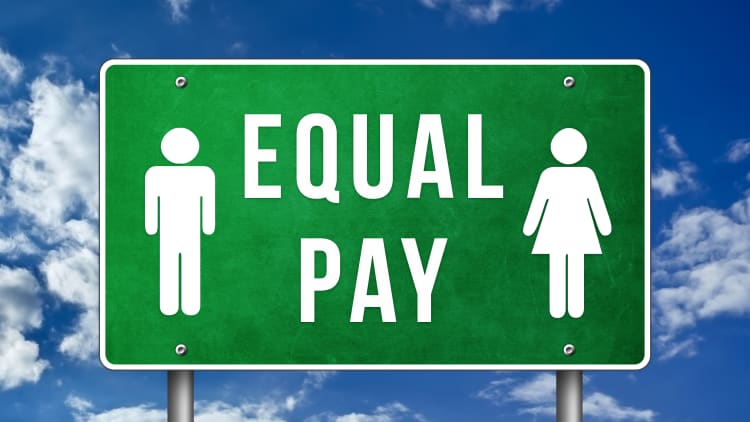Gender diversity training programs have become almost as common as Ping-Pong tables and free snacks at tech offices.
A recent report from AnitaB.org, formerly known as the Anita Borg Institute, found that 8 in 10 tech companies offer formal gender diversity training programs, a number that's been increasing steadily upward for the last three years. Amid the #TimesUp and #MeToo movements, companies are facing a rising wave of criticism from investors, employees and the public to address the issue. Plus, now that the talent war is so fierce, companies are prioritizing this issue. They want to cast a wide net so they can attract employees of all backgrounds. They can no longer afford to keep a culture that isn't all inclusive.
The trend toward more training belies a growing body of research showing that such programs often don't work. Still, tech companies and experts say there are benefits to diversity training, and robust programs that compliment other diversity and inclusion initiatives can truly benefit a company.
At the same time, companies realize they have to move the needle and spark change. Statistics tell the story. Companies are less likely to hire women than men for entry-level jobs, even though women are more likely to hold a college degree. The disparities continue as they move through their careers. For every 100 men promoted to a manager role, only 79 women are promoted, according to research by McKinsey and LeanIn.org. If companies continue to promote and hire at current levels, the number of women in management would increase by only 1 percent over the next 10 years.
More from At Work:
IBM artificial intelligence can predict which workers are about to quit
Basecamp CEO Jason Fried: 'One of tech's worst inventions is the shared calendar'
"You need a systemic, sustainable approach," says Sara Taylor, president and founder of deepSEE Consulting, which provides diversity and inclusion training for organizations. "Check-the-box training is not going to make a difference."
For this to work, the corporate culture has to be one that is committed to inclusion, according to Diane Gherson, senior vice president of human resources at IBM. As she explains, IBM chair, CEO and president Ginni Rometty "is leading a movement to develop a diverse workforce worldwide." This year the CEO instituted worldwide inclusion standards requiring all of the company's 350,000 employees to adhere to.
On the gender front, Gherson notes that there are now 50,000 female engineers in the IBM workforce.
Moving the needle is not easy, but crucial. Nearly half of millennials want to work at diverse companies, a 2017 research report by the Institute for Public Relations revealed. But efforts to boost diversity at organizations have been slow at best. Women still hold fewer than a third of all tech jobs, reports PayScale.
Once in tech jobs, women are less likely than men to be promoted and more likely to switch industries. Gender diversity training is aimed at stanching those losses, with specific programming intended to help all workers understand the value of gender diversity and reduce the barriers to gender-inclusive teams. The training itself can take myriad forms, from one-time online training sessions to ongoing, more holistic programs. As they attempt to make their training more effective, tech companies are increasingly moving toward the latter.
A sense of belonging
It's easy to understand why. The sector has drawn criticism for a lack of female representation at all levels. As companies focus on hiring more women, diversity training will make them feel they belong in the workplace and ensure they are promoted at the same rate as men, experts say. The most effective diversity training takes a more intersectional approach, offering training that aims to make all underrepresented groups feel comfortable, beyond just women.
"Aggressive recruiting goals don't matter much if the people you hire don't feel represented and supported," says Square spokeswoman Samantha Verdile.
At Square the company has a variety of training initiatives, including voluntary "Interrupting Bias" training, which offers participants tools to spot and cut off bias as they see it happening in real time.

The organization has also developed an "inclusion playbook," which provides research-backed tools that leaders can implement as needed on their teams. Leaders might be coached to ask for initial input on a project via a shared document rather than in a group meeting, for example, to allow for input from voices that may not be the loudest or strongest. Or they might try keeping a log of who they're spending time with during work to see whether some direct reports are consistently getting more or less time than others.
Making such training voluntary is key to its success, Taylor says.
"Everyone — from rank-and-file employees through senior leadership — should go through the training, but you don't want folks to feel like it's being pushed on them," she says. "When employees feel as though they have to go, rather than that they want to go, they don't take it in."
Instead of making training mandatory on a set time and day, companies should incentivize employees by providing different training options and making additional leadership opportunities available to those that have completed the training, Taylor says.
For example, a company might say that 25 percent of the members of a hiring panel this year need to have completed gender diversity training, Taylor says. That number might go up to 75 percent by next year and 100 percent in three years. The company's not requiring that employees take the training, but those who want to be on the hiring panel will choose to do so.
Everyone — from rank-and-file employees through senior leadership — should go through the training, but you don't want folks to feel like it's being pushed on them.Sara Taylorpresident and founder of deepSEE Consulting
It's also important to make sure that the company's leadership is sharing the value of the training and discussing their experience going through it.
That's been working at PayPal, where the organization is having all of its 18,700 employees participate in its "conscious inclusion" training this year but opted not to dictate when individual employees participate.
The training aims to help employees understand how different identities shape the way they interact with the world and how they can change those interactions to be more inclusive. Participants share personal stories and insights, and trained facilitators hired by PayPal help to promote conversation and talk about areas for improvement.
As employees take part in the 90-minute training, they've been discussing their experiences with colleagues, prompting them to sign up as well.
"We wanted to change the approach so that people felt like they wanted to do it," says Louise Pentland, the company's executive vice president and chief business affairs and legal officer. "It becomes a little bit viral."
The training itself takes place in a live small-group environment of just 30 people. The company opted for that setting in an effort to make participants feel more comfortable to engage and speak freely.
'You have to invest in this forever'
PayPal is looking at ways to expand the training, including creating a program designed specifically for leaders, which will focus on inclusion across the entire employee life cycle — from recruiting to retention and development. Women make up 43 percent of PayPal's workforce, including 37 percent of of the company's vice presidents roles, a 9 percent increase since 2015.
"You have to invest in this forever," Pentland says. "It's not something you get a certificate for and then you're an expert."
In addition to gender diversity training, tech companies are also putting in place other programs aimed at closing the gender gap. About 65 percent of tech companies, including GoDaddy and Dell, have formal leadership development programs for women, and 66 percent have a formal pay equity policy, according to the AnitaB.org report.
At IBM, returnship and apprenticeship programs are helping women, minorities and other diverse workers gain access to opportunities for high-paying tech jobs. These allow women who might have taken a hiatus from their careers to raise a family return to the workforce and get retraining so they can gain coveted skills in everything — from blockchain to software coding.
The tech giant's apprenticeship program that is registered with the Department of Labor, allows people who may not be able to afford a four-year college degree, or want to make a career switch, to obtain tech skills in high demand and then be placed in job roles.
"When you add in things like apprenticeship programs, boot camps, attending conferences, creating more exposure and opportunity for women and people of color, that changes how effective your diversity program can be," says Julian Green, director of diversity, equity, and inclusion guidance at AnitaB.org.
Companies also need to invest in additional types of training programs as well, says Jennifer Crittendon, author of "The Discreet Guide for Executive Women: How to Work Well with Men (and Other Difficulties)."
"If we're going to be serious about diversity, we have to be serious about the other things that come with it — conflict training, mediation, really appreciating when someone has a different opinion from our own," she says. "We can't just say that we want to have a diverse workforce and this is what it's going to look like."






